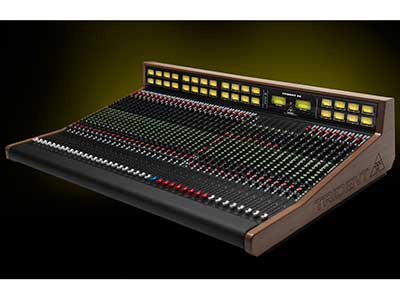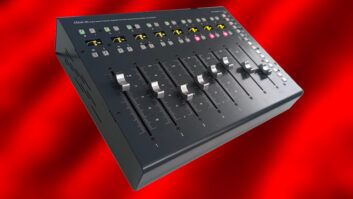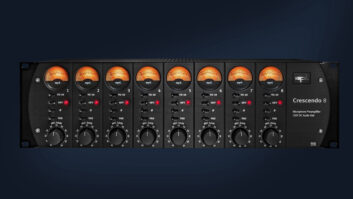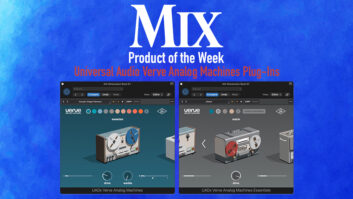
It’s that time of year where a couple of us at Mix get to put together a recording setup for a specific price. Once again I’ve been put in charge of the full analog studio for $100K. Let’s assume we already have our computer and furniture in place, ready to be loaded up with amazing analog gear.
This is my fourth installment of the Build Your Own Studio series, so in addition to a few trusted regulars, I’ve incorporated a bunch of “new faces” that haven’t been featured yet. The following is inspired mostly by personal experience and in-the-field use, complemented by choices based on feedback from colleagues. Now let’s go shopping!
The Great British Sound
As our centerpiece to handle all recording and mixing duties, I’ve chosen the Trident Series 88-32 ($34,999.99). The Trident name is synonymous with world-renowned EQ and a great sound originally made famous in St. Anne’s Court, London.
This 32-channel console will supply all the mic pre’s needed to track a band. The 88 can be configured as an in-line or split console, providing all the routing options to cover studio requirements.
The console is fully modular, allowing for easy maintenance. I wanted to point that out, especially as we find ourselves in more situations where there is no on-site maintenance staff. So having access to a modern console offering a modular design could save a session when one of the modules goes down and it needs to be replaced with a spare.
The desk features 4-band sweepable EQs on each channel, including a tilt EQ on the monitor path. There’s low and high shelving on the FX and monitor returns. And with its eight aux sends and eight subgroups, this is a very flexible, true analog board.
The Engine Room
In order to remain flexible with other studios and people’s various workflows, we need to record to a DAW. We can still track to a trusty 2-inch reel-to-reel multitrack; however, we still need to be able to deliver sessions in the digital format. Avid’s Pro Tools 12 ($599) will take on the recorder duties for us. And to feed into our DAW, I’ve spec’d Antelope’s Orion 32 ($2,795). The Orion 32 provides plenty of analog I/O, with a vast array of digital expansion possibilities and, of course, Antelope’s notorious clocking.
When it comes to dealing with automation moves in the DAW, I prefer to have access to several parameters at the same time. The Slate Raven MTi2 ($999) will insert analog-style touch to the software.

Slate Raven MTi2
On the Way In
Now we’re ready for some signal input, so let’s fill the microphone cupboard with some tasty tools. In all likelihood, we’ll be looking at the general recording setup: drums, bass, guitars and vocals. But our mic selection should be versatile enough to cover any eventuality.
Having spent quite a bit of time in the studio with hip-hop programmers and vocalists over the past few months, I’ve grown to love the Shure SM7b ($349). It is killer at recording vocals in the control room, with great rejection of the stuff coming over the monitors. They’re also great on heavy guitars. Just in case there’s more separation required, the sE Electronics Reflextion Filter Pro ($119) will do just that.
No mic collection would be complete without a couple of Shure SM57s ($99 x 2 = $198). These workhorses will cover snares, guitars and pretty much anything you throw at them.
On kick detail, the AKG D12VR ($499.99) will do the donkeywork, and we’ll supplement that with a Telefunken M82 ($399) and an Electro-Voice RE20 ($449), which can also take on a lot of bass and brass recording.
I recently worked with a producer who introduced me to the technique of putting a Sennheiser MD441U ($899.95) on the snare. Until now, I’ve always used SM57s and KM 84s, but hearing that Sennheiser on snare drums was absolutely mind-blowing. I do like putting a small condenser on the side of the snare drum, just looking over the rim, and the Advanced Audio CM1084 ($659) sounds just great for that. On toms, I’m sticking with the Sennheiser MD421s ($379.95 x 3= $1,139.85).
My magic hi-hat microphone has always been the AKG C451B ($499.99), and recently I’ve had fabulous results with the sE Electronics Rupert Neve designed RN17 ($999). The AKG also performs nicely on acoustic guitars, giving you that zingy string sound. Completing the small-diaphragm collection is the very open-sounding Lauten Audio Torch ST221 ($899).

sE Electronics Rupert Neve designed RN17
Having used these mics successfully on so many sessions now, I have to revisit the Advanced Audio 47 fet ($295), CM251 ($995) and the CM67se ($965 x 2 = $1,930). I love the 47 fets on double bass, and the CM251 performs amazingly on acoustic guitars, vocals and strings.

Advanced Audio CM251
The CM67se is my mic of choice for vocals. The last time I used it at RAK Studios, the producer asked me to put up an original vintage Neumann U 67. It’s in great shape and has been maintained very well. We went through the same API pre, and both got a little squeeze on a Fairchild. After recording one verse, the producer asked me to unplug the original 67 and keep on recording with the Advanced Audio. I like to use two of those mics so we can cover stereo applications and Glyn Johns-style drum recordings.
For piano recording, I am a champion of a couple of original 414s. Because those are no longer made, we’re swapping them out with a couple of Advanced Audio CM414s ($389 x 2= $778), inspired by that original design.
And that brings us to the missing link in our mic selection: ribbons. To complement the 414s on piano, it’s really lush to add a Royer SF12 ($2,695) stereo ribbon.
I’ve always liked ribbon mics on guitar cabs, and the Royer R-121 ($1,295) has done me proud on countless occasions. On my recent jobs engineering for Elliott Randall, we haven’t had access to the Royer, so we’ve been using an sE Electronics Rupert Neve designed RNR1 ($1,995), which has been sounding stellar on trumpets and saxophone.
Topping off the ribbon family is the AEA KU4 ($4,356). This hyper-cardioid ribbon is something else entirely. I had the opportunity to put it to use on a classical piano session at British Grove Studios. One of the pieces had a vocal, and the KU4 blew all the vintage tube mics straight out of the water. It was warm, smooth, and yet nicely open on top. Not what you expect from a ribbon. It impressed me enough to put it on this list. Rounding out the input section are a couple of Rupert Neve Designs RNDIs ($269 x 2 = $538).
Rack-and-Roll
The 500 Series is a widespread phenomenon now, and almost every manufacturer has jumped onboard. I’ve installed a value-for-money 10-slot Fredenstein Bento 10 ($531) holding a few sets of EQs, Crane Song Insigna ($1,299 x 2 = $2,598) and Pultec EQP500A ($1,295 x 2 = $2,590) that can be used on single channels, but will also serve for bus EQing.
The Shadow Hills Industries Dual Vandergraph ($2,085) and the Smart Research C1LA ($1,750) will take care of any stereo compression, while the Little Labs Vog ($420) will deliver low-frequency substance to kicks, snares, toms, bass and anything that warrants a touch of extra oomph.

Shadow Hills Industries Dual Vandergraph
The DAW will have plenty of time-based effects, but this studio has a tactile approach, so filling up the Bento 10 is the brand new Meris Mercury 7 ($549), a very cool reverb unit.

Meris Mercury 7
No studio is complete without API and Manley. The API 2500 ($2,800.75) and Manley Variable Mu ($3,960) are stunning-sounding units with amazing character and can be used on any material.

API 2500
Tying off the dynamics section is the Chandler RS124 ($2,875). Based on the original EMI Abbey Road unit, which can be heard on a lot of Beatles records, this compressor is the don when it comes to severe squeezing.
The final piece of outboard has to be a bit special. Last year when I engineered the Comsat Angels at RAK, we used a vintage tube Watkins Copicat ($720) as the main “space” on vocals instead of reverbs, and it sat just right in the mix. So I promptly hunted around for one and added it to my mix toolkit.

Watkins Copicat
Let’s Be Heard
I’ve chosen two pairs of monitors: Neumann KH 310s ($4,499.90) for transparency and the very flexible Barefoot Micromain 35 Gen2s ($8,275).

Barefoot Micromain 35 Gen2
Nothing is more important than your artists being able to hear themselves properly in the live area. That’s why I’m installing an Aviom D800 system ($1,599) with four Aviom A320 ($399 x 4 = 1,596) personal mixers. The headphones of choice are Audio Technica ATH-M70x ($299 x 4 = $1,196).
Make It Sound Great
All the gear is in place. This setup works great for recording, mixing and even some basic mastering.
Music production is both fun and intense. To provide a little distraction and comic relief, I’m bringing in theBB-8 ($149.99) as a little studio mascot of sorts.
A couple of 27-inch Grande Lava lamps ($99.99 x 2 = 199.98) help to set the mood and provide a bit of ambience. Any leftover cash will be spent on a few bottles of Jack Daniels in honor of the late, great Lemmy.
Grand total: $99,775.39
Click here to read how multimedia producer Markkus Rovito would outfit his studio for $35,000.







